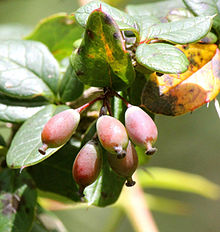
Berberis aquifolium, the Oregon grape or holly-leaved barberry, is a species of flowering plant in the family Berberidaceae, native to western North America. It is an evergreen shrub growing 1–3 meters tall and 1.5 m (5 ft) wide, with pinnate leaves consisting of spiny leaflets, and dense clusters of yellow flowers in early spring, followed by dark bluish-black berries.

Rubus spectabilis, the salmonberry, is a species of bramble in the rose family Rosaceae, native to the west coast of North America from west-central Alaska to California, inland as far as Idaho. Like many other species in the genus Rubus, the salmonberry plant bears edible fruit, typically yellow-orange or red in color, resembling raspberries in appearance.

Mahonia is a formerly accepted genus of approximately 70 species of shrubs or, rarely, small trees with evergreen leaves in the family Berberidaceae, native to eastern Asia, the Himalaya, North America, and Central America. They are closely related to the genus Berberis and as of 2023 the majority of botanical sources list it as a synonym for Berberis.

Symphoricarpos, commonly known as the snowberry, waxberry, or ghostberry, is a small genus of about 15 species of deciduous shrubs in the honeysuckle family, Caprifoliaceae. With the exception of the Chinese coralberry, S. sinensis, which is indigenous to western China, all species are native to North and Central America. The name of the genus is derived from the Ancient Greek words συμφορεῖν (sumphoreîn), meaning "to bear together", and καρπός (karpós), meaning "fruit". It refers to the closely packed clusters of berries the species produces.

Berberis, commonly known as barberry, is a large genus of deciduous and evergreen shrubs from 1–5 m (3.3–16.4 ft) tall, found throughout temperate and subtropical regions of the world. Species diversity is greatest in South America and Asia; Europe, Africa and North America have native species as well. The best-known Berberis species is the European barberry, Berberis vulgaris, which is common in Europe, North Africa, the Middle East, and central Asia, and has been widely introduced in North America. Many of the species have spines on the shoots and all along the margins of the leaves.

Arctostaphylos uva-ursi is a plant species of the genus Arctostaphylos widely distributed across circumboreal regions of the subarctic Northern Hemisphere. Kinnikinnick is a common name in Canada and the United States. Growing up to 30 centimetres in height, the leaves are evergreen. The flowers are white to pink and the fruit is a red berry.
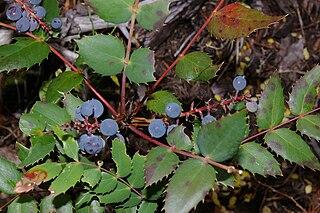
Berberis nervosa, commonly known as dwarf Oregon-grape, Cascade barberry, Cascade Oregon-grape, or dull Oregon-grape, is a flowering plant native to the northwest coast of North America from southern British Columbia south to central California, with an isolated population inland in northern Idaho. It is especially common in second growth, Douglas-fir or western redcedar forests, making use of those pools of sunlight that intermittently reach the ground.
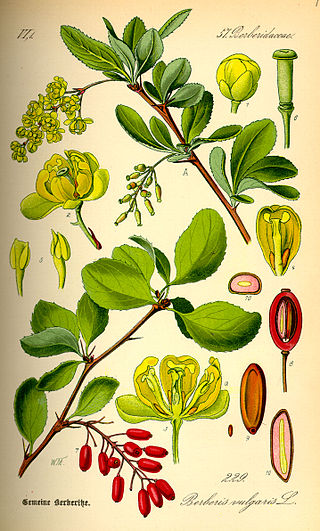
Berberis vulgaris, also known as common barberry, European barberry or simply barberry, is a shrub in the genus Berberis native to the Old World. It produces edible but sharply acidic berries, which people in many countries eat as a tart and refreshing fruit.

Xanthorhiza simplicissima (yellowroot) is the only member of the genus Xanthorhiza, and one of very few genera in the family Ranunculaceae with a woody stem. It is native to the eastern United States from Maine south to northern Florida and west to Ohio and eastern Texas. It contains the alkaloid berberine, which has a number of traditional and contemporary uses for dyeing and medicine.
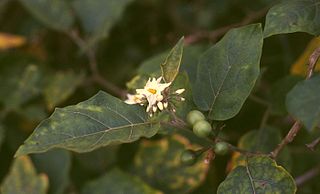
Solanum torvum, also known as pendejera, turkey berry, devil's fig, pea eggplant, platebrush or susumber, is a bushy, erect and spiny perennial plant used horticulturally as a rootstock for eggplant. Grafted plants are very vigorous and tolerate diseases affecting the root system, thus allowing the crop to continue for a second year.

Berberine is a quaternary ammonium salt from the protoberberine group of benzylisoquinoline alkaloids, occurring naturally as a secondary metabolite in some plants including species of Berberis, from which its name is derived.
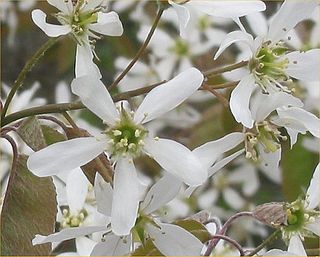
Amelanchier canadensis is a species of Amelanchier native to eastern North America in Canada from Newfoundland west to southern Ontario, and in the United States from Maine south to Alabama. It is largely restricted to wet sites, particularly on the Atlantic coastal plain, growing at altitudes from sea level up to 200 m.

Berberis trifoliolata is a species of flowering plant in the family Berberidaceae, in southwestern North America. Common names include agarita, agrito, algerita, currant-of-Texas, wild currant, and chaparral berry. The name Agarita comes from the Spanish verb agarrar, which means "to grab". The ending "-ita" is often added to little things, so agarita means "grabs a little". This was probably said because the bush is a bit scratchy but does not have significant spines. Typical characteristics are grey-green to blue-grey leaves, yellow flowers in February to April and the red berries appearing in May. The most important harvest organ are the berries, though the roots and seeds can also be used.

Berberis fortunei is a species of shrub in the family Berberidaceae, the barberry family, described in 1846. It is endemic to China, found in the provinces of Chongqing, Guangxi, Guizhou, Hubei, Hunan, Jiangxi, Sichuan, Taiwan, and Zhejiang. It is grown as an ornamental in many lands, with common names including Chinese mahonia, Fortune's mahonia, and holly grape.
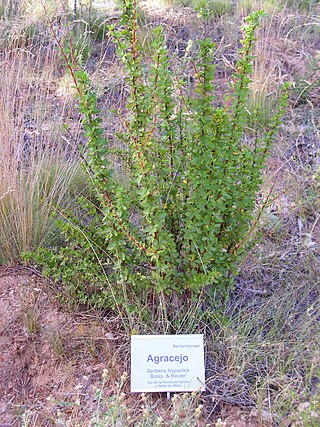
Berberis vulgaris subsp. australis, synonym Berberis hispanica, is a shrub belonging to the family Berberidaceae and the genus Berberis. It is a woody plant and parts of the plant are considered toxic, although the berries are edible and juicy.

Berberis koreana, the Korean barberry, is deciduous shrub that can grow up to 5 feet (1.5 m) in height. The species is endemic to Korea. It is widely planted as an ornamental tree in North America, South America and Europe.

Thapsia villosa, commonly known as the villous deadly carrot, is a species of poisonous herbaceous plants in the genus Thapsia. It grows to about 70 to 190 cm in height. It has pinnate hairy leaves with sheath-like petioles. The flowers are yellow in color and borne on compound umbels. They develop into fruits with four wings characteristic of the genus. It is native to southwestern Europe and northwestern Africa surrounding the Mediterranean Sea. The plant was used extensively for traditional medicine since around the 3rd century BC.

Berberis bealei, also known as leatherleaf mahonia, Beale's barberry, is a species of evergreen shrub native to mainland China. The species has been regarded as the same species as Berberis japonica, native to Taiwan, but the two differ consistently in certain floral and leaf characters. Both species are widely cultivated in many countries as ornamentals. Berberis bealei has reportedly escaped cultivation and become established in the wild in scattered places in the south-eastern United States from Arkansas to Florida to Delaware.
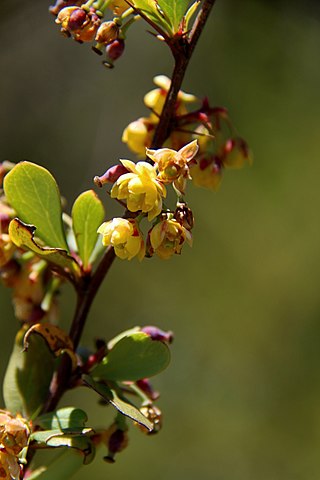
Berberis holstii is a spiny evergreen shrub assigned to the barberry family, with simple leaves, hanging panicles with a few yellow flowers and eventually blackish-blue berries. It is one out of only species of Berberis that grow in the wild in Africa, where it can be found at high altitudes in Tanzania, Uganda, Kenya, Ethiopia, Somalia, and Malawi. It is also reported from Yemen and Oman. In Malawi it is known as Kayunga, while in Ethiopia it is called Gewo, Yeset af in Amharic, as well as Zinkila, a name also used in the Afar language, and Godxantool in the Somali language.

Vaccinium praestans, the Kamchatka bilberry, is a perennial shrub in the family Ericaceae, which includes species like cranberries, blueberries, and huckleberries. In Russia this plant is known as the Klopovka, or stink-bug berry, due to its distinct, potent scent, resembling that of a secretion produced by bugs of Heteroptera genus. The plant is native to Kamchatka but can be found in North America to Eastern Asia. Mostly growing in the wild, it is also enjoyed as an ornamental plant, most commonly in Japan, where it is used to decorate home gardens. Like many other species in the family Ericaceae, its berries are edible.

